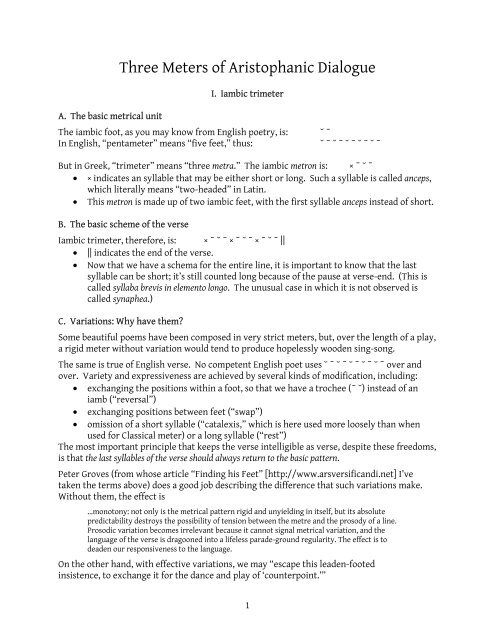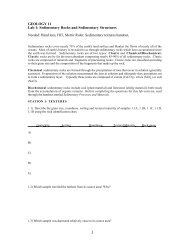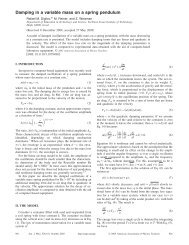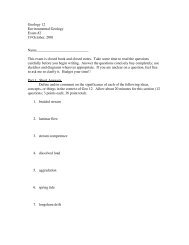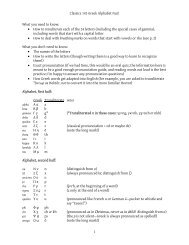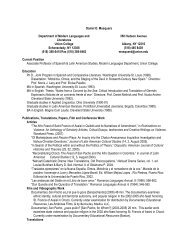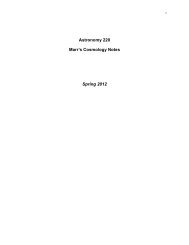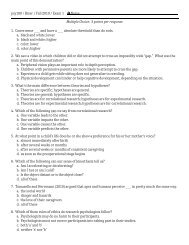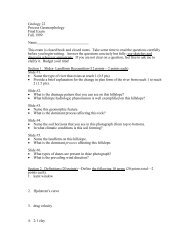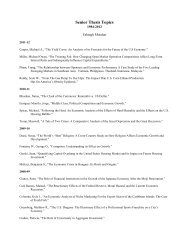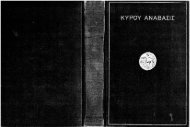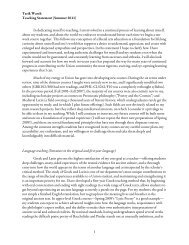Three Meters of Aristophanic Dialogue
Three Meters of Aristophanic Dialogue
Three Meters of Aristophanic Dialogue
You also want an ePaper? Increase the reach of your titles
YUMPU automatically turns print PDFs into web optimized ePapers that Google loves.
<strong>Three</strong> <strong>Meters</strong> <strong>of</strong> <strong>Aristophanic</strong> <strong>Dialogue</strong><br />
I. Iambic trimeter<br />
A. The basic metrical unit<br />
The iambic foot, as you may know from English poetry, is: ˘ ¯<br />
In English, “pentameter” means “five feet,” thus: ˘ ¯ ˘ ¯ ˘ ¯ ˘ ¯ ˘ ¯<br />
But in Greek, “trimeter” means “three metra.” The iambic metron is: × ¯ ˘ ¯<br />
• × indicates an syllable that may be either short or long. Such a syllable is called anceps,<br />
which literally means “two-headed” in Latin.<br />
• This metron is made up <strong>of</strong> two iambic feet, with the first syllable anceps instead <strong>of</strong> short.<br />
B. The basic scheme <strong>of</strong> the verse<br />
Iambic trimeter, therefore, is: × ¯ ˘ ¯ × ¯ ˘ ¯ × ¯ ˘ ¯ ||<br />
• || indicates the end <strong>of</strong> the verse.<br />
• Now that we have a schema for the entire line, it is important to know that the last<br />
syllable can be short; it’s still counted long because <strong>of</strong> the pause at verse-end. (This is<br />
called syllaba brevis in elemento longo. The unusual case in which it is not observed is<br />
called synaphea.)<br />
C. Variations: Why have them?<br />
Some beautiful poems have been composed in very strict meters, but, over the length <strong>of</strong> a play,<br />
a rigid meter without variation would tend to produce hopelessly wooden sing-song.<br />
The same is true <strong>of</strong> English verse. No competent English poet uses ˘ ¯ ˘ ¯ ˘ ¯ ˘ ¯ ˘ ¯ over and<br />
over. Variety and expressiveness are achieved by several kinds <strong>of</strong> modification, including:<br />
• exchanging the positions within a foot, so that we have a trochee (¯ ˘) instead <strong>of</strong> an<br />
iamb (“reversal”)<br />
• exchanging positions between feet (“swap”)<br />
• omission <strong>of</strong> a short syllable (“catalexis,” which is here used more loosely than when<br />
used for Classical meter) or a long syllable (“rest”)<br />
The most important principle that keeps the verse intelligible as verse, despite these freedoms,<br />
is that the last syllables <strong>of</strong> the verse should always return to the basic pattern.<br />
Peter Groves (from whose article “Finding his Feet” [http://www.arsversificandi.net] I’ve<br />
taken the terms above) does a good job describing the difference that such variations make.<br />
Without them, the effect is<br />
…monotony: not only is the metrical pattern rigid and unyielding in itself, but its absolute<br />
predictability destroys the possibility <strong>of</strong> tension between the metre and the prosody <strong>of</strong> a line.<br />
Prosodic variation becomes irrelevant because it cannot signal metrical variation, and the<br />
language <strong>of</strong> the verse is dragooned into a lifeless parade-ground regularity. The effect is to<br />
deaden our responsiveness to the language.<br />
On the other hand, with effective variations, we may “escape this leaden-footed<br />
insistence, to exchange it for the dance and play <strong>of</strong> ‘counterpoint.’”<br />
1
D. The variations in comic iambic trimeter<br />
Resolution, which means the substitution <strong>of</strong> ˘˘ where the strict scheme calls for a long syllable.<br />
This produces the modified scheme:<br />
× ⏕ ˘ ⏕ × ⏕ ˘ ⏕ × ⏕ ˘ ¯ ||<br />
Note that the intelligibility principle mentioned above dictates that the last foot remain<br />
iambic. There is one further variation, which is that an anapest (˘˘¯) may be substituted in any<br />
foot but the last. (Tragedy allowed fewer variations: see Birds 1238-1242, in a “tragic” style.)<br />
E. The full scheme <strong>of</strong> the comic iambic trimeter<br />
So the full scheme is:<br />
× ⏕ ˘ ⏕ × ⁞ ⏕ ˘ ⁞ ⏕ × ⏕ ˘ ¯ ||<br />
˘˘ ¯ ˘˘ ¯ ˘˘ ⁞ ¯ ˘˘ ⁞ ¯ ˘˘ ¯<br />
⁞ marks a possible caesura (see below). Note that, for each foot, you will find either one <strong>of</strong> the<br />
possibilities allowed in the first line or an anapest. You can’t mix and match beyond that point<br />
(i.e., a ˘˘˘˘ foot is not allowed).<br />
F. Caesura<br />
A caesura is a more or less regular break in the line (between words) that occurs in the middle <strong>of</strong><br />
a foot. In iambic trimeter, there is frequently a caesura between the two halves <strong>of</strong> the third or<br />
fourth foot (not both: don’t be misled by the fact that both possibilities are marked above).<br />
EXAMPLES from Birds / shows a change <strong>of</strong> speaker mid-verse<br />
54 ᾱλλ᾽ οῑσθ᾽ ο̆ δρᾱσο̄ν; ⁞ τῳ̄ σκε̆λεῑ θε̆νε̆ τη̄ν πε̆τρᾱν. foot 5 (θε̆νε̆ τη̄ν): anap. ο̆δρ,πε̆τρ mute+liquid<br />
55 σῠ δε̆ τῃ̄ κε̆φᾰλῃ̄ γ᾽, ῐν᾽ ῃ̄ δῐπλᾰσῐο̆ς ō ψŏφο̄ς. feet 1-2: anapest foot 4 (δῐπλᾰσῐ) resolved<br />
σῠ δ᾽ οῡν λῐθῳ̄ κο̄ψο̄ν λᾰβω̄ν. / πᾰνῠ γ᾽, εῑ δο̆κεῑ. foot 5: anap.<br />
παῑ παῑ. / τῐ λε̆γεῑς, οῡτο̄ς; το̆ν ε̆πο̆πᾰ παῑ κᾰλεῑς; foot 2: anap. foot 4 (το̆ν ε̆πο̆) resolved<br />
οῡκ ᾱντῐ τοῡ παῑδο̄ς σ᾽ ε̆χρη̄ν ε̆πο̆ποῑ κᾰλεῑν; ε̆χρ mute+liquid foot 5: anap.<br />
ε̆πο̆ποῑ. πο̆η̄σεῑς τοῑ με̆ κο̄πτεῑν αῡθῐς αῡ. foot 1: anap.<br />
60 ε̆πο̆ποῑ. / τῐνε̆ς οῡτοῑ; ⁞ τῐς ο̆ βο̆ω̄ν το̄ν δε̄σπο̆τη̄ν; foot 1: anap. foot 3 (τοῑ; τῐς ο̆) resolved<br />
ᾰπο̄λλο̆ν ᾰπο̆τρο̆παῑε̆, ⁞ τοῡ χᾱσμη̄μᾰτο̄ς. foot 2 (λο̆ν ᾰπο̆) resolved<br />
οῑμοῑ τᾰλᾱς, ο̄ρνῑθο̆θη̄ρᾰ τοῡτω̆ῑ. ω̆ by correption before ι (not discussed here)<br />
οῡτω̄ ᾽στῐ δεῑνο̆ν; ⁞ οῡδε̆ κᾱλλῐο̄ν λε̆γεῑν;<br />
ᾰπο̆λεῑσθο̆ν. / ᾱλλ᾽ οῡκ ε̄σμε̆ν ᾱνθρω̄πω̄. / τῐ δαῑ; foot 1: anap.<br />
65 ῠπο̆δε̆δῐω̄ς ε̆γω̄γε̆, ⁞ Λῐβῠκο̆ν ο̄ρνε̆ο̄ν. feet 1 (ῠπο̆δε̆) and 4 (γε̆, Λῐβῠ) resolved<br />
152 ᾱλλ᾽ εῑσῐν ε̆τε̆ροῑ ⁞ τη̄ς Λο̆κρῐδο̆ς ο̆ποῡντῐοῑ, feet 2 & 4 resolved; Λο̆κρ mute+liq.; foot 5: anap.<br />
206 ω̄ φῑλτᾰτ᾽ ο̄ρνῑθω̄ν σῠ, ⁞ μη̄ νῡν ε̄στᾰθῑ·<br />
ᾱλλ᾽ ᾱντῐβο̆λω̄ σ᾽ ᾰγ᾽ ⁞ ω̄ς τᾰχῑστ᾽ εῑς τη̄ν λο̆χμη̄ν foot 2: anap. λο̆χμ mute+liquid<br />
208 εῑσβαῑνε̆ κᾱνε̆γεῑρε̆ ⁞ τη̄ν ᾰη̄δο̆νᾱ.<br />
802 γε̆λοῑο̆τε̆ρο̆ν οῡκ εῑδο̆ν ⁞ οῡδε̆πω̄πο̆τε̄ foot 2 (ο̆τε̆ρο̆) resolved<br />
1390 καῑ πτε̆ρο̆δο̆νη̄τᾰ· ⁞ σῠ δε̆ κλῠω̄ν εῑσεῑ τᾰχᾱ feet 1 and 3 resolved δε̆ κλ mute+liquid<br />
1391 οῡ δη̄τ’ ε̆γω̄γε̆· /⁞ νη̄ το̆ν η̄ρᾰκλε̆ᾰ σῠ γε̄. foot 5 (ρᾰκλε̆ᾰ) resolved, mute+liquid<br />
2
II. Trochaic tetrameter catalectic<br />
Trochee (foot): ¯ ˘<br />
Trochaic metron: ¯ ˘ ¯ × (the mirror image <strong>of</strong> the iambic metron)<br />
Trochaic tetrameter: ¯ ˘ ¯ × ¯ ˘ ¯ × ¯ ˘ ¯ × ¯ ˘ ¯ × ||<br />
Catelexis means the suppression <strong>of</strong> a verse’s final syllable. In this case, this again serves the<br />
purpose <strong>of</strong> making the verse form intelligible by means <strong>of</strong> a distinctive verse-end.<br />
Trochaic tetrameter catalectic: ¯ ˘ ¯ × ¯ ˘ ¯ × ¯ ˘ ¯ × ¯ ˘ ¯ ||<br />
The full scheme, with resolutions everywhere except the final metron:<br />
⏕ ˘ ⏕ × ⏕ ˘ ⏕ × ⁞ ⏕ ˘ ⏕ × ¯ ˘ ¯ ||<br />
⁞ marks a regular diaeresis—a more or less regular break in the line (between words) that occurs<br />
between feet. In trochaic tetrameter catalectic, there is regularly a diaeresis after the second<br />
metron (i.e., at the verse’s “midpoint”).<br />
EXAMPLES from Birds<br />
How to recognize it: A bit longer. The only dialogue meter that can (& mostly does) begin ¯ ˘ ¯.<br />
268 ω̄γᾰθ’ ᾱλλ’ οῡν οῡτο̆σῑ καῑ ⁞ δη̄ τῐς ο̄ρνῐς ε̄ρχε̆ταῑ<br />
νη̄ ∆ῐ’, ο̄ρνῑς δη̄τᾰ τῑς πο̆τ’ ⁞ ε̄στῐν; οῡ δη̄ποῡ τᾰω̄ς;<br />
270 οῡτο̆ς αῡτο̄ς νῳ̄ν φρᾰσεῑ. τῐς ⁞ ε̄στῐν οῡρνῐς οῡτο̆σῑ;<br />
οῡτο̆ς οῡ τω̄ν η̄θᾰδω̄ν τω̄νδ’ ⁞ ω̄ν ο̆ρᾱθ’ ῠμεῑς ᾰεῑ,<br />
ᾱλλᾰ λῑμναῑο̄ς. / βᾰβαῑ, κᾰλο̄ς γε̆ καῑ φοῑνῑκῐοῡς.<br />
εῑκο̆τω̄ς γε̆· καῑ γᾰρ ο̆νο̆μ’ αῡτῳ̄ ’στῐ φοῑνῑκο̄πτε̆ρο̄ς. foot 4 (ο̆νο̆μ’ αῡ) resolvedπ<br />
οῡτο̆ς, ω̄ σε̆ τοῑ. / τῐ βω̄στρεῑς; /⁞ ε̆τε̆ρο̆ς ο̄ρνῐς οῡτο̆σῑ. foot 5 (ε̆τε̆ρο̆ς) resolved<br />
275 νη̄ ∆ῐ’ ε̆τε̆ρο̄ς δη̄τᾰ, χοῡτο̆ς ⁞ ε̄ξε̆δρο̄ν χω̄ρᾱν ε̆χω̄ν. foot 2 (ε̆τε̆ρο̄ς) resolved; ε̆δρ mute+liquid<br />
τῑς πο̆τ’ ε̄σθ’ ο̆ μοῡσο̆μᾱντῐς ⁞ ᾰτο̆πο̆ς ο̄ρνῐς ο̆ρῐβᾰτη̄ς; feet 5 and (irregularly) 7 resolved<br />
ο̆νο̆μᾰ τοῡτῳ̄ μη̄δο̆ς ε̄στῐ. /⁞ Μη̄δο̆ς; ω̄νᾱξ η̄ρᾰκλεῑς, foot 1 (ο̆νο̆μᾰ) resolved; ᾰκλ mute+liquid<br />
278 εῑτᾰ πω̄ς ᾰνεῡ κᾰμη̄λοῡ ⁞ Μη̄δο̆ς ω̄ν εῑσε̄πτᾰτο̄;<br />
3
III. Anapestic tetrameter catalectic<br />
This is a chanted meter especially associated with the opposing speeches in a debate scene<br />
(agōn) and the parabasis (speech in which the chorus addresses the audience).<br />
Anapest (foot): ˘ ˘ ¯<br />
Anapestic meter is varied, not by resolution, but by allowing substitutions <strong>of</strong> dactyls or<br />
spondees for anapests.<br />
Dactyl (foot): ¯ ˘ ˘<br />
Spondee (foot): ¯ ¯<br />
The anapestic metron consists <strong>of</strong> two feet (like the iambic and trochaic metra), with all three<br />
possibilities allowed in each foot.<br />
Anapestic metron [A]: ˘ ˘ ¯ ˘ ˘ ¯ with any pairing <strong>of</strong> anapests,<br />
¯ ˘ ˘ ¯ ˘ ˘ dactyls, and spondees allowed<br />
¯ ¯ ¯ ¯<br />
As in iambic (and trochaic) meter, even with all the possible substitutions, a ˘˘˘˘ foot is not<br />
allowed (Birds 688, in the example below, is a rare exception). In this meter, the ˘˘˘˘ sequence<br />
is also prohibited across two feet (i.e., dactyl + anapest).<br />
Using A to designate the anapestic metron, the full scheme <strong>of</strong> anapestic tetrameter catalectic is:<br />
A ⁞ A ⁞ A ˘ ˘ ¯ ¯<br />
Again, the first foot <strong>of</strong> the final metron requires a true anapest, to keep the verse form<br />
intelligible. There is regularly a diaeresis after the second metron, and usually also after the<br />
first metron.<br />
EXAMPLES from Birds<br />
How to recognize it: These lines are long! (And the ending ˘ ˘ ¯ ¯ is distinctive.)<br />
685 ᾰγε̆ δη̄ φῠσῐν ᾱνδρε̆ς ᾰμαῡρο̆βῐοῑ, ⁞ φῡλλω̄ν γε̆νε̆ᾱͅ προ̆σο̆μοῑοῑ,<br />
ο̆λῐγο̄δρᾰνε̆ε̄ς, ⁞ πλᾱσμᾰτᾰ πη̄λοῡ, ⁞ σκῐο̆εῑδε̆ᾰ φῡλ’ ᾰμε̆νη̄νᾱ, epic scansion: ο̄δρ (mute+liq.)<br />
ᾱπτη̄νε̆ς ε̆φη̄με̆ρῐοῑ τᾰλᾰοῑ ⁞ βρο̆τοῐ ᾱνε̆ρε̆ς εῑκε̆λο̆νεῑροῑ, epic correption: βρο̆τοῐ ᾱνε̆ρε̆ς<br />
προ̆σε̆χε̆τε̆ το̄ν νοῡν ⁞ τοῑς ᾱθᾰνᾰτοῑς ⁞ η̄μῑν, τοῑς αῑε̆ν ε̆οῡσῑν,<br />
τοῑς αῑθε̆ρῐοῑς, ⁞ τοῑσῐν ᾰγη̄ρῳ̄ς, ⁞ τοῑς ᾱφθῐτᾰ μη̄δο̆με̆νοῑσῑν,<br />
foot 1 irreg. resolved: προ̆σε̆χε̆τε̆<br />
690 ῐν’ ᾰκοῡσᾱντε̄ς ⁞ πᾱντᾰ πᾰρ’ η̄μω̄ν ⁞ ο̄ρθω̄ς πε̆ρῐ τω̄ν με̆τε̆ω̄ρω̄ν,<br />
φῠσῐν οῑω̄νω̄ν ⁞ γε̆νε̆σῑν τε̆ θε̆ω̄ν ⁞ πο̆τᾰμω̄ν τ’ ε̆ρε̆βοῡς τε̆ Χᾰοῡς τε̄<br />
692 εῑδο̆τε̆ς ο̄ρθω̄ς, ⁞ Προ̆δῐκῳ̄ πᾰρ’ ε̆μοῡ ⁞ κλᾱεῑν εῑπη̄τε̆ το̆ λοῑπο̄ν.<br />
Further reading<br />
For more on these meters, see D.S. Raven, Greek Metre: An Introduction, London, 1962, whose<br />
information I have adapted in places above.<br />
© 2007 Tarik Wareh<br />
4


